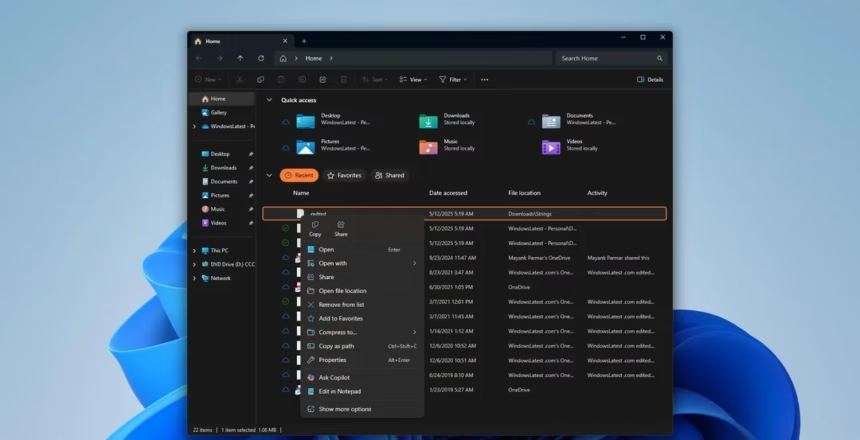Turn off Microsoft Copilot data sharing in Windows 11—simple, step-by-step privacy settings with screenshots. Finish in 5 minutes without breaking your PC.
Copilot is built into Windows 11 and Edge. Helpful, but it may share data with Microsoft and your account. If you want a quieter system, you can turn off a few switches and keep your work local. This guide focuses on Microsoft Copilot in Windows 11 and the related privacy toggles in Settings, Edge, and Microsoft 365.
You will get a 5-minute checklist with exact menu paths, clear trade-offs, and safe defaults, followed by deeper steps. The steps fit Windows 11 versions 23H2 and 24H2. Names can change slightly after updates. We keep things simple for readers in the US, Canada, and the UK. Privacy laws like CCPA, PIPEDA, and the UK GDPR set the tone, but your choices in Settings matter today.
One promise, one outcome. Stronger privacy, no broken PC.
Quick-start checklist: turn off these Windows 11 switches in 5 minutes
Use these steps now, then review the details below.
- Settings > Privacy & Security > Diagnostics & feedback > Send optional diagnostic data: Off (less device data sent; some suggestions may be less accurate)
- Diagnostics & feedback > Tailored experiences: Off (reduces personalized tips; fewer Microsoft upsells)
- Privacy & Security > Inking & typing personalization: Off (stops cloud learning from your typing; may reduce suggestion quality)
- Privacy & Security > Speech > Online speech recognition: Off (keeps voice data local; cloud voice typing features may be limited)
- Privacy & Security > Activity history > Store my activity history: Off; select Clear history (less local tracking; Recents lists less valuable)
- Privacy & Security > Search permissions > Cloud content search: Off for This device and Microsoft account (search stays local; no cloud files in results)
- Privacy & Security > General > Let apps show me personalized ads by using my advertising ID: Off (less ad tracking; ads may still appear, but not personalized)
- System > Clipboard > Clipboard history: Off, or select Clear (reduces exposure of copied items; loses quick paste history)
- Personalization > Start > Show recommendations for tips, shortcuts, new apps, and more: Off (fewer content suggestions; Start may look simpler)
- Personalization > Taskbar > Copilot: Off or Hide (removes Copilot button; you can still open Copilot from the Start menu if enabled)
- Microsoft Edge > Settings > Sidebar > Copilot: Hide; and Appearance > Show Copilot button: Off (fewer AI prompts in Edge; Copilot can still be opened manually if needed)
- Edge > Settings > Privacy, search, and services > Personalization and Search suggestions: Off; and Clear browsing data on close: On for history, downloads, cookies, cache (privacy on exit; you will sign in more often)
Note: Paths can vary slightly between 23H2 and 24H2.
Turn off Copilot where it shows up in Windows 11 and Edge
Copilot appears on the taskbar, in Start and Search, inside Edge, and in some Microsoft 365 apps. Hiding it reduces prompts and lowers the chance of sending data by mistake. You can still use Windows normally.
Hide Copilot on the taskbar and reduce Start and Search extras
- Settings > Personalization > Taskbar > Copilot: Off or Hide (removes the Copilot taskbar button; you can still use Copilot if you launch it from elsewhere)
- Settings > Privacy & Security > Search permissions > Cloud content search: Off for both This device and Microsoft account (keeps Start search local; no cloud file results)
- Settings > Privacy & Security > Search permissions > Search history on this device: Off; Clear device search history (removes local search history)
- Settings > Privacy & Security > Search permissions > More settings > Show search highlights: Off (fewer rotating search graphics and tips)
- Settings > Personalization > Start > Show recommendations for tips, shortcuts, new apps, and more: Off (reduces Start suggestions)
Turn off the Microsoft Edge Copilot sidebar
- Edge > Settings > Appearance > Show Copilot button: Off (removes the button from the toolbar)
- Edge > Settings > Sidebar > Copilot: Hide (keeps sidebar from popping up)
- Edge > Settings > Sidebar > App and notification settings: Turn Off Allow sidebar apps to show notifications and Always show sidebar (fewer sidebar prompts)
Trade-offs: You lose quick AI access inside Edge; browsing remains normal.
Limit Microsoft 365 Copilot and connected experiences (if present)
- In Word, Excel, or PowerPoint: File > Options > Trust Center > Trust Center Settings > Privacy Options
- Turn off Optional connected experiences and related personalization switches (reduces cloud-assisted features)
Trade-offs: AI help and some online features in Office apps may not work.
For how Microsoft handles Copilot data in Office apps, see Microsoft’s guide on Copilot in Microsoft 365 apps for home: your data and privacy.
Windows 11 privacy settings to review and switch off
This is the core sweep. Follow the numbered steps for each area. Each step includes the reason and trade-off.
Diagnostics & feedback: stop extra data sharing
- Settings > Privacy & Security > Diagnostics & feedback > Send optional diagnostic data: Off (reduces telemetry)
- Diagnostics & feedback > Tailored experiences: Off (no personalized tips based on diagnostics)
- Diagnostics & feedback > Feedback frequency: Never (fewer prompts)
Trade-off: You may see fewer personalized suggestions.
For a broader context on Windows privacy controls, review Microsoft’s page on Change privacy settings in Windows.
Inking & typing personalization: keep text data local
- Settings > Privacy & Security > Inking & typing personalization: Off (stops cloud learning)
Trade-off: Typing suggestions may be less customized.
Online speech recognition and voice access: control voice data
- Settings > Privacy & Security > Speech > Online speech recognition: Off (voice stays local)
- Settings > Accessibility > Speech > Voice access: Off when not needed (reduces background listening)
Trade-off: Cloud voice typing and better dictation may be limited.
Activity history: reduce local tracking
- Settings > Privacy & security > Activity history > Store my activity history: Off
- Select Clear history (removes saved activities)
Trade-off: Recent lists can be shorter or empty.
Advertising ID and tailored experiences: cut ad tracking
- Settings > Privacy & Security > General > Let apps show me personalized ads by using my advertising ID: Off
- General > Show me suggested content in the Settings app: Off (fewer promos)
Trade-off: Ads may still appear, but they will be less targeted.
Search permissions and cloud content search: keep search local
- Settings > Privacy & security > Search permissions > Cloud content search: Off for both This device and Microsoft account
- Search permissions > Search history on this device: Off; select Clear device search history
- Search permissions > More settings > Show search highlights: Off
Trade-off: The Start search will not show cloud files or rotating highlights.
One sentence summary: These switches reduce telemetry, ads, and cloud suggestions without affecting core security.
Edge privacy and services: tighten the browser
Edge uses data to improve features such as shopping, suggestions, and AI prompts. Set strict defaults, then loosen per site if needed.
Tracking prevention: set it to Strict for privacy
- Edge > Settings > Privacy, search, and services > Tracking prevention: Strict
Trade-off: Some sites may not remember you or may break slightly. You can lower to Balanced per site.
Personalization and search suggestions: turn off extra data use
- Edge > Settings > Privacy, search, and services > Personalization & advertising > Personalize your web experience: Off
- Edge > Settings > Privacy, search, and services > Improve Microsoft products by sending optional diagnostic data: Off
- Edge > Settings > Privacy, search, and services > Address bar and search > Show me search and site suggestions using typed characters: Off
Trade-off: Fewer tailored results and fewer suggestions while typing.
Data sharing and services: disable shopping and creator prompts
- Edge > Settings > Privacy, search, and services > Services > Save time and money with Shopping in Microsoft Edge: Off
- Services > Show suggestions to follow creators in Microsoft Edge: Off
- Services > Get notifications of related things you can explore: Off
Trade-off: You lose coupon pop-ups and creator suggestions.
Clear browsing data every time you close Edge
- Edge > Settings > Privacy, search, and services > Clear browsing data > Choose what to clear every time you close the browser
- Turn On: Browsing history, Download history, Cookies and other site data, Cached images and files.
Trade-off: You will sign in to sites more often, and pages may load more slowly at first.
One line summary: With these changes, Edge stops most tracking and prompts while staying fast and usable.
Accounts, cloud, and app permissions: reduce background sharing
Sync and cloud features help you roam across devices. If privacy is the goal, reduce what leaves your PC and limit which apps can access it.
OneDrive sync choices and Windows backup
- OneDrive app > Settings > Sync and backup > Manage backup: Turn off folders you do not want in the cloud (like Desktop or Documents)
- Settings > Accounts > Windows backup: Turn Off Remember my apps and Remember my preferences if you prefer not to sync
Trade-off: Files and settings will not automatically roam across devices.
Clipboard history: clear or turn it off
- Settings > System > Clipboard > Clipboard history: Off; or choose Clear
Trade-off: You lose quick paste from recent items.
File and photo suggestions in Start and Search highlights
- Settings > Personalization > Start > Show recommendations for tips, shortcuts, new apps, and more: Off
- Settings > Privacy & security > Search permissions > More settings > Show search highlights: Off
Trade-off: Start and Search will look cleaner but less informative.
App permissions: microphone, camera, and location
- Settings > Privacy & Security > App permissions > Microphone: Turn off for apps you do not trust
- Camera: Turn off for apps you do not trust
- Location: Turn off for apps you do not trust; consider turning off Location Services entirely if you do not need it
- Optional: Settings > Apps > Installed apps > three dots > Advanced options > Background apps permissions: Never for chatty apps
Trade-off: Some apps will not capture audio, video, or location when disabled.
One sentence summary: Fewer sync points and tighter app permissions mean fewer surprises.
Safe defaults: what to keep on vs Off
These balanced settings protect privacy without breaking daily use.
- Keep Off (privacy-first):
- Optional diagnostic data; Tailored experiences; Advertising ID; Cloud content search; Search highlights; Start recommendations; Inking & typing personalization; Online speech recognition; Clipboard history (or clear often); Edge Copilot button and sidebar; Edge shopping and creator suggestions; Edge typed character suggestions; Clear browsing data on close (On for privacy)
- Keep On (safety and basic function):
- Windows Security and SmartScreen; Automatic updates; Disk encryption (BitLocker on Pro); Tracking prevention in Edge (Strict or Balanced); Firewall; Device Find my device only if you use it (else Off)
These defaults cut sharing while keeping security features active.
Work or school devices: what admins control and what you can still do
Company or school policies can lock Copilot, telemetry, OneDrive sync, and Edge settings. Respect your organization’s rules.
- Admin controls: Copilot availability, telemetry level, OneDrive sync folders, Edge policies, and some privacy toggles can be enforced.
- What you can still change: App permissions, Start recommendations, Search highlights, Edge clear-on-close, and some local privacy switches are usually open.
- If Copilot is enforced, You can hide taskbar buttons, reduce cloud content search, and limit Edge personalization to cut prompts.
Ask IT before changing anything that conflicts with policy. Even with policies in place, you can still boost privacy on your device.
Advanced privacy (optional): local account, DNS over HTTPS, and defaults
These options add protection without risky tweaks. Skip if you are happy with the settings above.
- Local account vs Microsoft account: Settings > Accounts > Your info > Sign in with a local account instead (reduces sync; you lose some cross-device features)
- DNS over HTTPS: Settings > Network & internet > Wi-Fi or Ethernet > Hardware properties > DNS server assignment > Edit. Choose Manual, set DNS servers that support encryption, and toggle Encrypt DNS to On (more private lookups; may affect captive portals)
- Use a different default browser and search engine: Settings > Apps > Default apps > Set your browser as default for .htm, .html, HTTP, and HTTPS. In your browser, pick a non-Bing search engine if you prefer
- Windows 11 Pro only: Group Policy path for reference, not a step-by-step edit: Computer Configuration > Administrative Templates > Windows Components > Windows Copilot > Turn off Windows Copilot (for managed or Pro users). If you need deeper technical steps, see Microsoft’s discussion on Disabling Copilot and personal privacy.
These options add extra privacy without risky tweaks.
FAQs
Does turning off Copilot break Windows 11?
No. Windows runs fine without Copilot. You may lose quick AI answers and suggestions. Core apps, updates, and security still work.
Is Copilot disabled for local accounts?
Some Copilot features rely on a Microsoft account. A local account reduces cloud features, but Copilot may still appear. You can still hide buttons and cut data sharing.
How is Copilot different in Edge vs Windows?
In Windows, Copilot integrates with system features and the Start search. In Edge, it lives in the sidebar and toolbar. You can hide each one separately in Settings.
Will turning off online speech recognition disable voice typing?
Voice typing can still work with local processing. Cloud accuracy and advanced dictation may be reduced when Online speech recognition is off.
Can my work or school account override these settings?
Yes. Admin policies can lock Copilot, telemetry, and Edge options. You can still adjust app permissions and turn on clear-on-close in Edge.
Can I limit Copilot data inside the Copilot app?
Yes. Open Copilot, select your profile icon, then Settings > Privacy. Turn Off model training and personalization to limit data use. See Microsoft’s note on Microsoft Copilot privacy controls.
Conclusion
You tightened privacy for Microsoft Copilot in Windows 11 with simple, safe switches. Your PC still works normally, and you can browse and work without constant prompts. Recheck these settings after major Windows updates, since labels and defaults can change.
Next steps:
- Review app permissions monthly.
- Clear the clipboard and Edge data often.
- Keep Windows Security, SmartScreen, and updates on.
For more on Windows privacy and general settings, Microsoft maintains a helpful guide on Windows privacy settings.
Safe defaults protect your data while keeping Windows helpful.















